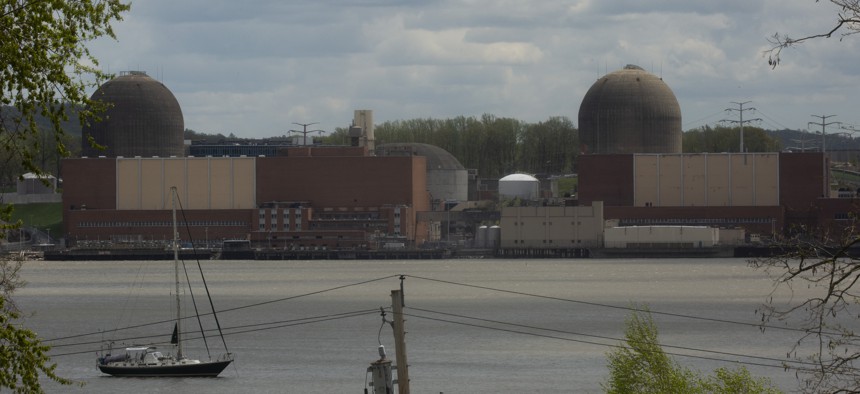On Aug. 18, Gov. Kathy Hochul signed Assembly Bill 7208/Senate Bill 6893, colloquially known as the “Save the Hudson” bill, into law. The enactment of this legislation, which I sponsored in the Assembly, followed months of advocacy by New Yorkers opposed to the discharge of nuclear waste from the decommissioning Indian Point Energy Center into the Hudson River. The “Save the Hudson” effort holds lessons – and warnings – for the entire state as we plan our energy mix now and into the future.
First and foremost, the “Save the Hudson” effort must be understood as a victory for citizen action. Leading advocacy organizations like Riverkeeper and Food & Water Watch were joined by more than 100 grassroots groups of activists working together, devoting countless unpaid hours to the cause. As a result of skillful organizing and collective effort, nearly 450,000 people signed a petition opposing the discharge. Thousands also wrote to my office and legislators around the state supporting legislation on this issue; by a wide margin, this was the number one issue I heard about from constituents during this legislative session.
Public outrage spurred elected officials into action, on both sides of the aisle. Thirty-five municipalities passed resolutions in support of the legislation. A bipartisan group of five county executives came together to oppose the discharge, as did the entire Hudson Valley congressional delegation. Support was bipartisan in the state Senate and the Assembly, and the Senate passed the legislation unanimously. Holtec International, the company that operates the Indian Point plant, was able to induce some last minute opposition to the bill in the Assembly with questionable threats of layoffs at the plant, but the bill still passed 101-44, again with bipartisan support.
Advocates then turned their focus to ensuring the bill was signed into law. They kept the pressure on all summer, organizing phonebanks and even bird-dogging the governor at events unrelated to the issue. Additional alarm was raised following a July 31 public forum hosted by the Indian Point Decommissioning Oversight Board, during which we learned that although regulators require pre-release testing for discharges of wastewater from nuclear power plants, the Nuclear Regulatory Commission was prepared to allow Holtec to proceed with discharging their radioactive wastewater without waiting for all of the results of those tests. Unknown quantities of strontium-90 could have been released along with the tritiated wastewater, potentially exposing members of the public to a known carcinogen linked to bone cancer and leukemia in children. We considered this to be a mockery of the purpose of pre-release testing, so six of my seven colleagues in the Westchester Assembly delegation joined me in sending a letter to the governor reiterating the importance of the legislation. An additional 23 of my Assembly colleagues, from all corners of the state, amplified these concerns in another letter to Hochul one week later, on the same day that advocates and elected officials from the local and state levels rallied in support of the legislation. Three days later, the bill was signed.
The experience of working on this legislation has been eye-opening. My first takeaway is that the public and its elected representatives must be vigilant monitors of both decommissioning and active nuclear plants, along with regulators; it is a major challenge to ensure that nuclear plant operators manage their waste appropriately. A recently-publicized whistleblower report from Holtec’s Pilgrim Plant in Massachusetts alleges that the plant is secretly shifting to evaporating their tritiated water without having appropriate testing and oversight mechanisms in place. I have also received messages from two former Indian Point employees alleging that sometimes, violations have been kept quiet due to a culture of intimidation. There is also just a lot of room for unintentional errors with potentially hazardous results, as we learned recently when improperly packaged material made its way from Oyster Creek in New Jersey to Indian Point, emitting more than double the permissible amount of radiation along the way.
Elected officials should also know that the politics of this issue appear to be shifting in ways they may not realize. Contrary to the caricature of anti-nuclear activists as “boomer environmentalists,” some of the strongest opposition to Indian Point discharges in my district came from mothers of school-age children, who are millennials and young Gen-Xers. And the bipartisan support the legislation received from the region’s elected officials is a direct reflection of the fact that constituents on both the left and the right were opposed to Holtec’s plans. Case in point: I was a recent guest on WABC’s Cats & Cosby talk radio show, invited to reassure the hosts and their listeners that nuclear waste would not be dumped into the river in a segment wedged between interviews with Karl Rove and Rudy Giuliani. Events like the Norfolk Southern derailment in East Palestine, Ohio seem to have made it possible to incorporate opposition to toxic chemicals, corporate polluters and failures of government regulation into America’s current strain of populist conservatism.
In light of the controversy from which the "Save the Hudson" legislation emerged, and as images from Fukushima protests flash across our screens, the idea that opposition to nuclear energy is fading with time seems fanciful. As we look to shift our energy consumption away from fossil fuels, we would do well to keep this in mind and consider focusing on energy sources with fewer and more easily managed externalities than nuclear energy. That means speeding up our adoption of renewables. So much progress has been made on this front, and we can continue to make more progress by looking squarely at the pros and cons of all of our energy choices.
Dana Levenberg is a member of the state Assembly representing northern Westchester County and western Putnam County. Her district includes the Indian Point nuclear power plant.
NEXT STORY: Commentary: Siena poll paints warning signs for Democrats in New York state


